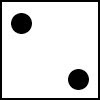The school year is now over for me. That is a bittersweet statement, because I still have mountains of grading and report card comments to do, but there will be no more direct lessons in the 2010/2011 school year. I found myself nostalgic this morning, and began to recount the good times in the classroom. I recalled the probability mayhem that ensued with my Grade 11s. It was very amusing to see them come up with ways to describe “fair”. I would always tell them that I would only do something if it was “fair”. This, to them, meant a coin flip, draw from a hat, or a roll of the die. But whose hat? Who rolls the die? On what surface? Do these factors actually have an impact on “fair”?
Most questions with elementary probability include a fair clause. For example:
“Flip a fair coin 3 times, what is the probability that at least 2 flips will produce a tails?”
This fairness clause is supposed to wipe away all doubt that the theoretical probability matches the experimental. It also preempts those smug students who always find a corner case in the trial. Some kids would rather put their energy into being difficult rather than productive. I spent a considerable amount of time in class working on fair games, but never stopped to wonder if the pieces were fair themselves.
Take a die for example. We assume, as mathematicians, that each side has an equal chance of being rolled on a “fair” dice. Have you ever considered these 4 characteristics of a standard dice that may, in fact, make even a “fair” die act with bias?
1) If every marking on the die is concave (hollowed out), and each of these hollows are identical, then the die is actually weighted toward the 1 side. Isn’t it logical that a heavier side would more likely land on the bottom than a lighter side? If that is the case, then 6 would be rolled far more often than 2 because the 6 is opposite a relatively heavy 1 side and the 2 is opposite a relatively light 5 side. This problem is easily remedied by large gaming establishments through scaling of the hollows. The gouges are all done proportionately so the same amount of material is removed from each face. Your typical board game dice however, will carry this “unfair” flaw.
2) The opposite sides of the dice sum to 7. This was surprising to me at first, but makes perfect sense. This means that if the dice (being 3 dimensions) has three axes, then an equal amount of material is removed (7 dots) from every set of opposite faces. This may seem to make the dice more fair, but think of this:
as the numbers grow further and further apart, the difference between their weights grows.
The difference between the 3 and 4 is only 1 dot–maybe this is negligible. The difference between 2 and 5 is 3 dots–three times worse than the first spread. The difference between 1 and 6 is 5 dots. This may be enough to ensure that the much lighter side shows up more often. It would take a large test to see if there is a relationship between the 3-4, 2-5, and 1-6 ratios. Again, this problem is easily solved by taking an identical amount of material from each side.
3) The center of gravity on each face affects the outcome. If we look at the 6 standard organizations of dots, we see interesting patterns:
Every edge of the face has the same pattern of hollows, except the 6. It is simple to see the symmetry in the 1, 4, and 5 faces. The dice look the same no matter how you rotate them. The 2 and 3 faces take some work, but it can be shown that each face is symmetrical using a combination of reflection and rotation. The 6 side however does not have this symmetry.
Two of the edges have 3 dots along them, and 2 have 2 dots. This results in an unbalance in the configuration. In a random toss, an unbalanced dice may turn toward a lighter edge. This could favour a 2 or 5 over a 3 or 4. It would be interesting to have students come up with a symmetrical design for 6 dots. What about 7? 8? I digress.
4) Each edge of the die does not have the same weight on either side. The die has 12 edges, and each one is formed by 2 sides. Along each edge there will be a certain number of hollows. For example, let’s look at the 5-6 edge:
Here we see that the edge (which has been flattened) is not symmetrical. There is more weight on the 5-side because there are less hollows along the edge. (The 5-side has 2 and the 6-side has 3). If a dice was teetering between 5 and 6 on this edge, would this difference in weight make a difference? The 3-2 edge is balanced with 1 hollow a piece:


This exercise pleads to my curious spirit. It would be a great exercise to have a class find as many balance flaws in a die as possible. I am sure some of these would come up. After the problems are identified, the teacher could commission the groups to create a truly “fair” die. One that shows no favourites. It would also be interesting to use these 4 facts to guess which sides roll more often. A large-scale class test would reveal the results. This is only the introduction into a very interesting concept of fairness. Maybe it is fitting that, so close to Father’s Day, I can almost hear my dad’s voice, “Sometimes, life isn’t fair.” Maybe even the most objective tools we have in society prove to be unfair when put under intense scrutiny.
NatBanting



